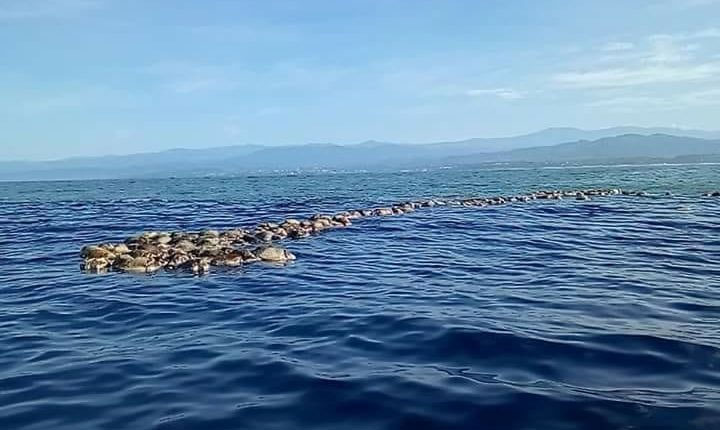Hundreds of deadly Golfinas sea turtles are found in the Mexican coast
On August 28, the government of Oaxaca, Southern Mexico, bordering on the Pacific Ocean, announced the discovery of more than 300 rare sea turtles Golfinas (also known as Olive Ridley) drowning along the local coast.

The rare sea turtle Golfinas drifted along the coast of Oaxaca state, southern Mexico.(Photo: realidadoaxaca.com).
According to Mexican correspondent, state official Oaxaca said a few days earlier, fishermen also discovered more than 100 turtles in the area and the federal environmental protection agency is investigating the cause of death. of Golfinas series of sea turtles in recent times. The beaches of the Pacific bordering states of Mexico are the places where 6/7 sea turtles exist in the world choose to nest and breed every year. Mexico has established nature reserves to protect rare and endangered turtles.
The National Committee for Mexican Nature Reserves (CONAP) says that according to the annual natural breeding cycle, about 500,000 individuals of Golfinas often land on Ayuta beaches in the cities of San Pedro and Santiago Astata Huamelula, Oaxaca state, to nest, lay eggs and every reproductive cycle has about 15 million baby turtles born.

Mexico discovered more than 300 rare sea turtles died off along the coast.(Photo: acustiknoticias.com).
Golfinas is the largest of the sea turtles in Mexico with a breeding cycle from June this year to April next year. The time when turtles make their nests and spawn the most in the period of August-October. The turtle breeding season has always been monitored, supervised and protected by CONAP, the Mexican National Center for Sea Turtle, the Federal Prosecutor for Environmental Protection and the Mexican Navy.
Golfina turtles, up to 75cm in length and up to 45kg in weight, are one of the most endangered species and are listed in Appendix I of the International Convention on the prohibition of trade in endangered wild animals and plants ( CITES). They are found in tropical waters, off the North Indian Ocean, East Pacific and Eastern Atlantic Ocean.
- Mysterious hundreds of dead sea turtles floating in the Pacific Ocean
- Humans have been cheated for hundreds of years by turtles without knowing
- Hundreds of sea turtles
- Watch the athletics turtle
- How do sea turtles find their eggs?
- Many rare and precious Vietnamese turtles appear in Chinese markets
- Impressed by hundreds of thousands of turtles landing on the beach
- The most exotic turtles in the world
- Thousands of extinct turtles to Nicaragua's coast lay eggs
- Rare sea turtles die in mass in Mexico
- Huge giant turtle by car
- Hundreds of barrels of radioactive waste are found off the US coast
 Animal 'suffering' after hibernation
Animal 'suffering' after hibernation Why do goats climb well?
Why do goats climb well? Scientists were surprised to see chimpanzees eating turtles
Scientists were surprised to see chimpanzees eating turtles Giant catfish died deadly due to drought in Thailand
Giant catfish died deadly due to drought in Thailand Ancient giant turtle as big as a rhinoceros, extinct 66 million years ago salvaged
Ancient giant turtle as big as a rhinoceros, extinct 66 million years ago salvaged  Hundreds of 'cold-shocked' sea turtles washed ashore
Hundreds of 'cold-shocked' sea turtles washed ashore  Strangely, the gentle turtle is a nightmare for predators and scientists
Strangely, the gentle turtle is a nightmare for predators and scientists  The secret of cold-blooded animals' 'young and old forever'
The secret of cold-blooded animals' 'young and old forever'  What hasn't happened in modern times: World's rarest sea turtle lays eggs in Texas
What hasn't happened in modern times: World's rarest sea turtle lays eggs in Texas  Why do turtles have shells?
Why do turtles have shells? 